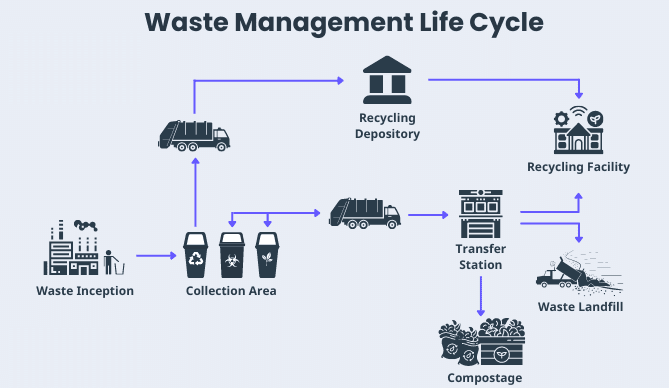Waste management plays a crucial role in environmental conservation by implementing recycling strategies that minimize waste, conserve resources, and reduce pollution. But how does waste management recycle effectively? This guide explores the structured process of recycling, covering collection, sorting, processing, and repurposing waste materials into new products.
Introduction to Waste Management Recycling
Recycling is an integral part of sustainable waste management. It involves converting waste materials into reusable products to prevent excessive landfill use and environmental pollution. Waste management companies handle large-scale recycling efforts through specialized facilities and innovative techniques.
What is Waste Recycling?
Waste recycling is the process of converting waste materials into new, reusable products. The goal is to reduce waste generation, conserve natural resources, and promote sustainability.
Importance of Recycling
Why is recycling essential? Here are some key benefits:
- Environmental Protection – Reduces landfill waste and pollution.
- Resource Conservation – Saves natural resources like water, trees, and minerals.
- Energy Efficiency – Manufacturing recycled products consumes less energy.
- Economic Growth – Creates jobs in the recycling industry.
| Benefit | Impact |
| Reduces Pollution | Minimizes air, water, and land pollution |
| Saves Energy | Less energy-intensive than raw material extraction |
| Conserves Resources | Preserves forests, water, and minerals |
| Economic Benefits | Generates employment and revenue |
How Does Waste Management Recycle?
Recycling involves several critical steps to ensure waste is efficiently processed and repurposed. Let’s break it down step by step:
1. Collection of Recyclables
The first stage of recycling is collecting waste materials through various channels:
- Curbside Pickup – Households and businesses separate recyclables into bins for scheduled collection.
- Drop-off Centers – Public facilities allow individuals to drop off recyclable items.
- Deposit/Refund Programs – Refund incentives encourage the return of bottles and cans.
2. Sorting and Processing
After collection, waste materials are transported to Material Recovery Facilities (MRFs), where they are sorted using advanced methods:
- Manual Sorting – Workers separate items by hand, removing contaminants.
- Mechanical Sorting – Automated systems use weight, shape, and optical sensors to classify materials.
- Magnetic Separation – Extracts metals like aluminum and steel using magnets.
- Air Classification – Lighter materials (e.g., paper, plastic) are separated from heavier ones.
Fact: Did you know that over 75% of waste is recyclable, but only 30% is actually recycled?
3. Cleaning and Preparation
Recyclables must be cleaned before processing:
- Plastic is shredded, washed, and melted into pellets.
- Glass is crushed into cullet and melted to create new glass products.
- Paper is pulped, de-inked, and reformed into new paper.
- Metals are melted and refined for manufacturing new metal products.
4. Manufacturing New Products
Processed materials are then used to create new products:
- Recycled Plastic → Clothing, packaging, and new containers.
- Recycled Aluminum → Beverage cans, car parts, and electronics.
- Recycled Glass → Bottles, construction materials, and decorative items.
- Recycled Paper → Newspapers, office supplies, and notebooks.
5. Selling Recycled Products
Once processed, recycled goods are sold in the market, completing the recycling loop. Consumer participation in purchasing recycled products ensures sustainability.
Challenges in Waste Recycling
Despite its advantages, recycling faces obstacles:
| Challenge | Impact |
| Contamination | Reduces efficiency and quality of recycled materials. |
| High Processing Costs | Some materials are expensive to recycle. |
| Market Demand | Low demand for certain recycled products hinders profitability. |
Recycling Statistics and Trends
- Global Recycling Rate: 19% of waste is recycled globally.
- Plastic Waste: 91% of plastic isn’t recycled, ending up in landfills and oceans.
- E-Waste: Electronic waste is growing at a rate of 2 million tons per year.
Chart: Global Recycling Rates by Material Type
Material Recycling Rate (%)
Paper 68%
Aluminum 50%
Glass 35%
Plastics 9%
E-Waste 20%
Future of Waste Management Recycling
Emerging trends indicate the future of recycling will be driven by:
- AI & Robotics – Automated waste sorting for improved efficiency.
- Advanced Biodegradable Materials – Innovations in eco-friendly packaging.
- Circular Economy Initiatives – Promoting sustainable product life cycles.
Conclusion
Understanding how waste management recycles waste highlights the importance of proper waste disposal, sorting, and consumer participation in sustainability efforts. By reducing landfill dependency, saving natural resources, and embracing new recycling technologies, we can contribute to a healthier planet.
Would you like additional insights on specific recycling methods or waste reduction tips? Let’s keep the discussion going!

Leave a Reply